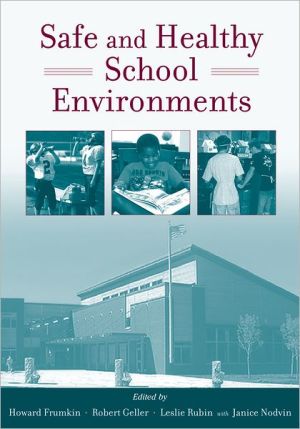Safe and Healthy School Environments
Millions of children and adults across the nation spend their days in school buildings, and they need safe, healthy environments to thrive, learn, and succeed. This book explores the school environment using the methods and perspectives of environmental health science. Though environmental healht has long been understood to be an important factor in workplaces, homes, and communities, this is the first book to address the same basic concerns in schools. The editors are physicians and...
Search in google:
Millions of children and adults across the nation spend their days in school buildings, and they need safe, healthy environments to thrive, learn, and succeed. This book explores the school environment using the methods and perspectives of environmental health science. Though environmental healht has long been understood to be an important factor in workplaces, homes, and communities, this is the first book to address the same basic concerns in schools. The editors are physicians and educators trained in pediatrics, occupational and environmental medicine, and medical toxicology, and the authors are experts in their fields drawn from across the United States and abroad. Each section of the book addresses a different concern facing schools today. In the first six sections, the various aspects of the school environment are examined. Chapters include the physical environment of the school, air quality issues, pest control, cleaning methods, food safety, safe designs of playgrounds and sports fields, crime and violence prevention, and transportation. In the last two sections, recommendations are made for school administrators on how to maximize the health of their schools. Appropriately evaluating the school environment, implementing strategies to address children and adults with disabilities, emphasizing health services, infectious disease prevention and recognition, and occupational health for faculty and staff are all addressed. The entire book is evidence-based, readable, generously illustrated, and practical. An indispensable resource for parents, school staff, administrators, government officials, and health professionals, this book is for anyone who cares about the health of our schools. Doody Review Services Reviewer:J. Thomas Pierce, MBBS PhD(Navy Environmental Health Center)Description:The authors explore the school environment from the perspective of environmental health sciences. The authors are physicians and educators trained in pediatrics, occupational and environmental medicine, and medical toxicology. It is astonishing that this has not been previously attempted. This book is what you need if you are involved with a pediatric environmental health specialty unit or similar enterprise. Purpose:The authors intend the book to be evidence-based, readable, generously illustrated, and practical. Its larger goal, creating and maintaining a suitable school environment, is important for parents, school staff, administrators, officials, and health professionals. In other words, this book is for all of us who care about the health of school children. Audience:The audience includes parents, school staff, administrators, and health professionals. It should become an accepted reference for all pediatric environmental health specialty units and similarly functioning organizations. It is written at a thorough enough level to permit its adaptation in a variety of circumstances. Rather than endless regulations, many of us need a book such as this that can serve as a guide.Features:In its first six parts, various aspects of the school environment are examined. These chapters include the physical environment of the school, air quality issues, pest control, cleaning methods, food safety, safe design for playgrounds, crime and violence prevention, and transportation. The last two parts make recommendations for school administrators to maximize the health of their schools. The book evaluates the school environment, implementing strategies to address children and adults with disabilities, emphasizing health services, infectious disease prevention and recognition, and occupational health for faculty and staff. It is both thorough and temperate in its treatment of difficult issues.Assessment:I liked this book a lot. Its balance of authors across continents (North America and Europe with some Pacific Rim experience) includes an eclectic mix of trainers, engineers, family and school learning specialists, and poison control personnel. The book isn't particularly preachy, but it insists upon an in-depth examination of issues. It takes on a thorough examination of the design characteristics needed for a high-performance school. The book provides remedies that can be attempted in districts where budgets are quite limited or in cases where so-called portable classrooms have become fixtures.
1Introduction : safe and healthy school environments3IThe physical environment of the school2Crowding, class size, and school size133Lighting204Noise345Temperature and humidity466Ergonomics for students and staff587Animal safety788Playgrounds : a 150-year-old model869Injury prevention104IIAir quality in schools10Indoor air quality12311Mold13312Outdoor air pollution141IIIToxic hazards in schools13Pest control15514Cleaning materials and methods16915Chemical exposures in and out of the classroom189IVNutrition and physical activity16Food safety20717Nutrition at school : creating a healthy food environment21818Safe and healthy sports environments238VViolence and disasters19Violence and crime prevention through environmental design25120Emergency management270VITransportation to and from school21Safe school travel29522Healthy school travel : walking and bicycling314VIIManaging for safe and healthy school environments23High-performance school buildings33124The economics of safe and healthy schools35725Evaluating the school environment36326Children and adults with disabilities377VIIIHealth services in schools : environmental health aspects27Health services at school : environmental considerations39728Care of asthmatic and allergic students41229Infectious disease in schools : prevention and control42130Occupational health and safety for faculty and staff432
\ Reviewer: J. Thomas Pierce, MBBS PhD(Navy Environmental Health Center)\ Description: "The authors explore the school environment from the perspective of environmental health sciences. The authors are physicians and educators trained in pediatrics, occupational and environmental medicine, and medical toxicology. It is astonishing that this has not been previously attempted. This book is what you need if you are involved with a pediatric environmental health specialty unit or similar enterprise. "\ Purpose: The authors intend the book to be evidence-based, readable, generously illustrated, and practical. Its larger goal, creating and maintaining a suitable school environment, is important for parents, school staff, administrators, officials, and health professionals. In other words, this book is for all of us who care about the health of school children. \ Audience: The audience includes parents, school staff, administrators, and health professionals. It should become an accepted reference for all pediatric environmental health specialty units and similarly functioning organizations. It is written at a thorough enough level to permit its adaptation in a variety of circumstances. Rather than endless regulations, many of us need a book such as this that can serve as a guide.\ Features: In its first six parts, various aspects of the school environment are examined. These chapters include the physical environment of the school, air quality issues, pest control, cleaning methods, food safety, safe design for playgrounds, crime and violence prevention, and transportation. The last two parts make recommendations for school administrators to maximize the health of their schools. The book evaluates the school environment, implementing strategies to address children and adults with disabilities, emphasizing health services, infectious disease prevention and recognition, and occupational health for faculty and staff. It is both thorough and temperate in its treatment of difficult issues.\ Assessment: I liked this book a lot. Its balance of authors across continents (North America and Europe with some Pacific Rim experience) includes an eclectic mix of trainers, engineers, family and school learning specialists, and poison control personnel. The book isn't particularly preachy, but it insists upon an in-depth examination of issues. It takes on a thorough examination of the design characteristics needed for a high-performance school. The book provides remedies that can be attempted in districts where budgets are quite limited or in cases where so-called portable classrooms have become fixtures.\ \








